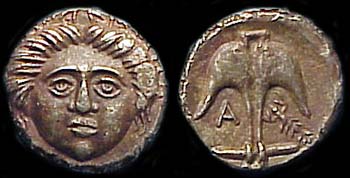This article originally appeared in the August 1997 issue of the Celator. While "old" the information it contains still offers good advice for collectors and it is worth reflecting on the "cotroversy" of the "Black Sea Hoard" more than ten years latter. It is also interesting to note that these coins continue to surface for sale regularly, in spite of how well documented they are -Editor. 
Will it ever die-this beast of the Black Sea? Oh yes, and with a puny whimper unbecoming such a hideous monster. All it took to end the Black Sea Hoard controversy was a capitalist merchant in a Bulgarian museum gift shop doing what comes naturally-selling useless trinkets to souvenir-hunting tourists.
The handwriting was on the wall last fall when dealers began showing up with fresh bags, full bags, of the Mesembria and Apollonia copies at prices that wouldn’t park a car in Chicago. It was only a matter of time until a reputable source could be nailed down. It’s a pitiful commentary that all of the arguments presented by knowledgeable numismatists over the past four years fell on deaf ears, and now the numismatic world is enlightened by a gift shop merchant in the Sofia, Bulgaria museum.
We could rave on and twist the dagger a little, but there is a more somber and sobering side to this whole affair. The credibility of the professional numismatic fraternity has suffered greatly during this episode, and it is not something that we can take lightly or dismiss as incidental. As a fraternity, we were faced with and serious and substantial challenge and we failed to meet it.
We applaud those dealers who stood up and openly cautioned their clientele against acquiring coins from this “hoard”; in some cases it might have been much easier, and safer, to simply ignore them and press on with business. By the same token, we are saddened by the inability of our fraternity to produce a leader who could and would coherently argue the case.
The “scientific” evidence presented in favor of the hoard’s authenticity is clearly unreliable, at least for the purpose at hand, and has been from the start. Every rational challenge to the scientific argument was met with a barrage of double talk. I wouldn’t be surprised to wake up in the morning and see an article in World Coin News or Coin World claiming that Mr. Kochev is actually selling authentic Mesembria and Apollonia coins in the gift shop because they are so much more common and so much cheaper than the fakes. How bizarre can this whole mess get?
Speaking of Coin World News and Coin World, I seldom criticize my compatriots at these venerable institutions. For the most part, they do a creditable service to collectors of ancient coins, and they help expose a lot of neophytes to the world of ancients. On this issue, however, they both laid a big egg.
So, where do we go from here? I personally think that all dealers who sold these copies as authentic should attempt to recall the pieces and refund the purchase price. Collectors who purchased them should contact the seller and request a refund. Trade in the pieces should cease immediately, and the International Bureau for the Suppression of Counterfeit Coins should publish a retraction of their previously stated position that the coins are ancient counterfeits.
Does this mean that counterfeiters can fool the most sophisticated equipment available to modern science? No, it simply means that the tests used to authenticate these coins are not foolproof. They are still good tests, but we should not rely on them to the exclusion of all other tests and indicators.
Are there other fakes lurking in the shadows? Certainly. Pliny the Elder (ca. 1st century A.D.) commented that in his time counterfeit gems and antiques were of substantial interest, and often brought higher prices than the originals. Renaissance collectors were plagued with forgeries, and the nineteenth century spawned a fresh wave of counterfeiters. It seems only reasonable that in this age of technological development we should find forgeries of all type, good and bad. The good news is that counterfeiters are not the only ones getting smarter!
Dealers can sometimes find themselves in a position where they do not have recourse if a coin is determined to be a forgery. The collector should never be placed in this position. Try to buy coins only from firms that guarantee authenticity without reservation or limitation. If you do buy from some other source, be forewarned that you have assumed the entire risk.
In the midst of all this warning and concern, however, keep in mind that there are thousands upon thousands of perfectly authentic ancient coins being sold every year. Although the sting is very real when you get bit, the chances are you can collect for a very long time without falling victim-and longer yet if you use a little common sense.
|